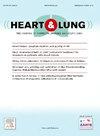冠心病患者多种炎症指数与心力衰竭的关系:中国RCSCD-TCM研究
IF 2.6
4区 医学
Q2 CARDIAC & CARDIOVASCULAR SYSTEMS
引用次数: 0
摘要
抗炎治疗可能成为治疗心力衰竭(HF)的新靶点,而多重炎症指数(multi -inflammatory index, MII)是由炎症指数组成的新指标。因此,MII与HF之间的关系尚不完全清楚。目的探讨冠心病(CHD)患者心肌梗死与心衰的关系。方法在17937例冠心病患者中,6386例合并心衰。采用Logistic回归分析冠心病患者MII与HF的关系。根据性别、血压和血糖来评估MII和HF之间的关系。结果与MII T1比较,MII-1 T3最高(OR: 1.33; 95% CI: 1.23 ~ 1.45; P < 0.001), MII-3 T3最低(OR: 1.25; 95% CI: 1.16 ~ 1.36; P < 0.001)。在两性中,与MII-2和MII-3相比,MII-1与HF的相关性更大。在二元logistic回归分析中,当MII作为一个连续变量处理时,MII-1与冠心病合并高血压患者(OR: 1.06; 95% CI: 1.02-1.10; P = 0.002)和冠心病合并糖尿病患者(OR: 1.04; 95% CI: 1.00-1.08; P = 0.040)的HF风险显著相关。所有MII均与HF相关。MII-1被证明是更好的。结论在冠心病患者中,女性心肌梗死与心衰的相关性强于男性。多因素调整后,冠心病患者的MII与HF风险之间存在关联。本文章由计算机程序翻译,如有差异,请以英文原文为准。
Association between multi inflammatory index and heart failure in patients with coronary heart disease: a RCSCD-TCM study in China
Background
Anti-inflammatory therapy could become a new target for the treatment of heart failure (HF), and multi inflammatory index (MII) is a new index composed of an inflammatory index. Then, the relationship between MII and HF is not completely clear.
Objectives
The aim of this study was to investigate the association of MII and HF in coronary heart disease (CHD) patients.
Methods
In a cohort of 17,937 patients with CHD, 6386 had HF. Logistic regression analysis was used to analyze the relationship between the MII and HF in CHD patients. The relationship between MII and HF was also assessed according to sex, blood pressure, and blood glucose.
Results
Compared with T1 of MII, MII-1 had the highest T3 (OR: 1.33; 95% CI: 1.23–1.45; P < 0.001), and MII-3 had the lowest T3 (OR: 1.25; 95% CI: 1.16–1.36; P < 0.001). In both sexes, MII-1 was more associated with HF than MII-2 and MII-3. In binary logistic regression analysis, when MII was treated as a continuous variable, MII-1 was significantly associated with HF risk in CHD patients with hypertension (OR: 1.06; 95% CI: 1.02–1.10; P = 0.002) and in CHD patients with diabetes (OR: 1.04; 95% CI: 1.00–1.08; P = 0.040). All MII were associated with HF. The MII-1 proved to be superior.
Conclusion
In patients with CHD, the association between the MII and HF was stronger in female than in male. There was a association between MII and risk of HF in with CHD patients after multivariate adjustment.
求助全文
通过发布文献求助,成功后即可免费获取论文全文。
去求助
来源期刊

Heart & Lung
医学-呼吸系统
CiteScore
4.60
自引率
3.60%
发文量
184
审稿时长
35 days
期刊介绍:
Heart & Lung: The Journal of Cardiopulmonary and Acute Care, the official publication of The American Association of Heart Failure Nurses, presents original, peer-reviewed articles on techniques, advances, investigations, and observations related to the care of patients with acute and critical illness and patients with chronic cardiac or pulmonary disorders.
The Journal''s acute care articles focus on the care of hospitalized patients, including those in the critical and acute care settings. Because most patients who are hospitalized in acute and critical care settings have chronic conditions, we are also interested in the chronically critically ill, the care of patients with chronic cardiopulmonary disorders, their rehabilitation, and disease prevention. The Journal''s heart failure articles focus on all aspects of the care of patients with this condition. Manuscripts that are relevant to populations across the human lifespan are welcome.
 求助内容:
求助内容: 应助结果提醒方式:
应助结果提醒方式:


